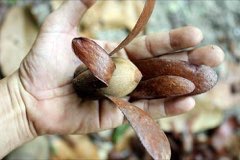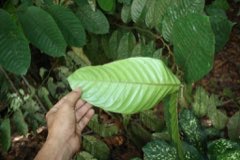 |
|
Ahmad Fuad Morad flickr.com |
 |
| Ahmad Fuad Morad flickr.com |
Translate this page:
Summary
Shorea macrophylla, otherwise known as Light Red Meranti, Engkabang or False Ilipe Nut, is a large tropical plant belonging in the Dipterocarpaceae family. It is endemic to Borneo. It has a dense, oblong to hemispherical crown, irregular bole that branches from fairly low down, and short buttresses. It grows up to 45 m in height and 150 cm in bole diameter. The seeds are ovoid and yield edible fat which can also be used to treat skin conditions or in making soap, candles, polishes, and cosmetics. The timber is of high quality and used for several purposes including panelling, joinery, light carpentry, boxes and crates, and veneer.
Physical Characteristics

 Shorea macrophylla is an evergreen Tree growing to 35 m (114ft) by 25 m (82ft) at a fast rate.
Shorea macrophylla is an evergreen Tree growing to 35 m (114ft) by 25 m (82ft) at a fast rate.
See above for USDA hardiness. It is hardy to UK zone 10.
Suitable for: medium (loamy) and heavy (clay) soils, prefers well-drained soil and can grow in heavy clay soil. Suitable pH: mildly acid, neutral and basic (mildly alkaline) soils. It cannot grow in the shade. It prefers moist soil.
UK Hardiness Map
US Hardiness Map
Synonyms
Hopea macrophylla de Vriese Pachychlamys gysbertsiana Ridl. Shorea bakeriana Heim Shorea gysbertsian
Plant Habitats
Edible Uses
Edible Parts: Oil Seed
Edible Uses: Oil
An edible fat obtained from the seeds has similar uses to Cacao butter (obtained from Theobroma spp.)[370 ].
References More on Edible Uses
Medicinal Uses
Plants For A Future can not take any responsibility for any adverse effects from the use of plants. Always seek advice from a professional before using a plant medicinally.
Skin
An edible fat obtained from the seed is easily absorbed by the skin. It can be used to treat skin problems and is often used as a carrier to apply other substances to the skin[370 ].
References More on Medicinal Uses
The Bookshop: Edible Plant Books
Our Latest books on Perennial Plants For Food Forests and Permaculture Gardens in paperback or digital formats.

Edible Tropical Plants
Food Forest Plants for Hotter Conditions: 250+ Plants For Tropical Food Forests & Permaculture Gardens.
More

Edible Temperate Plants
Plants for Your Food Forest: 500 Plants for Temperate Food Forests & Permaculture Gardens.
More

More Books
PFAF have eight books available in paperback and digital formats. Browse the shop for more information.
Shop Now
Other Uses
Cosmetic Lighting Oil Polish Soap making Wood
Other Uses: The seeds of many species in this genus, including this species, yield an oil that has an unusually high melting point and is solid at room temperature[317 , 370 , 884 , 899 ]. Average yields range from 45 - 70% according to species[370 ]. The fat is somewhat similar to Cacao butter (obtained from Theobroma spp.) and can be used in a variety of ways, often combined with cacao butter. In addition to it being edible, it has medicinal uses and can be used in making soap, candles, polishes and cosmetics[370 , 899 ]. The obovoid seeds are around 6cm long and 4cm wide[899 ]. The tree provides a high quality timber[370 ]. The wood is a source of 'Light Red Meranti'. We do not have any more specific information, but a general description of light red meranti follows:- The heartwood is light red to pink or pink-brown, with white resin streaks; it is clearly demarcated from the 5 - 8cm wide band of sapwood. The texture is medium; the grain interlocked with a ribbon-like aspect; the surface is lustrous. The wood is light in weight, soft, moderately durable, being resistant to dry wood borers, somewhat resistant to fungi and susceptible to termites. The wood seasons well with a slight risk of checking or distortion; once dry it is stable to moderately stable in service. The wood works well with normal tools, though the tools need to be kept sharp because it has a tendency towards woolliness; it generally finishes fairly well, though filling is recommended; screwing and nailing are good; gluing is correct. The wood is used for several purposes including interior and exterior panelling and joinery, light carpentry, boxes and crates, veneer etc[848 ].
Special Uses
References More on Other Uses
Cultivation details
A plant of lowland areas in the moist tropics, where it is found at elevations up to 600 metres[451 ]. Plants are tolerant of periodically inundated soils[451 ]. This species is one of the fastest growing trees in the genus[338 ]. Yields of 1,138 kg/ha of dried kernels have been reported[370 ]. The tree does not start to bear fruit until it is 18 - 25 years old[370 ].
References Carbon Farming Information and Carbon Sequestration Information
Temperature Converter
Type a value in the Celsius field to convert the value to Fahrenheit:
Fahrenheit:
The PFAF Bookshop
Plants For A Future have a number of books available in paperback and digital form. Book titles include Edible Plants, Edible Perennials, Edible Trees,Edible Shrubs, Woodland Gardening, and Temperate Food Forest Plants. Our new book is Food Forest Plants For Hotter Conditions (Tropical and Sub-Tropical).
Shop Now
Plant Propagation
We have no specific information for this species - the information below is a general guide for the genus. Seed - best sown as soon as possible. It does not require pre-treatment, but it is recommended to soak the seed for 12 hours prior to sowing[325 ]. The seeds are sown in seedbeds, where they are covered with a mixture of sand and soil (1:1) or with a thin layer of sawdust[325 ]. Germination of fresh seeds is usually good and rapid. About two weeks after germination, when the seedlings are 5 - 6cm tall, they are potted up into individual containers about 15 x 23cm with good drainage holes at their base[325 ]. It is normally recommended to use a mixture of forest soil and sand (at a ratio of 3:1) as the potting medium in order to introduce the appropriate mycorrhiza to the roots. The seedlings are placed in 50 - 60% sunlight and watered twice daily[325 ]. Seedlings can be planted out when 30 - 40cm tall - harden the seedlings off in full sunlight for one month prior to planting[325 ].
Other Names
If available other names are mentioned here
Light Red Meranti, Engkabang, False Ilipe Nut
Native Range
TROPICAL ASIA: Brunei Darussalam, Indonesia (Kalimantan), Malaysia (Sabah, Sarawak)
Weed Potential
Right plant wrong place. We are currently updating this section.
Please note that a plant may be invasive in one area but may not in your area so it's worth checking.
Conservation Status
IUCN Red List of Threatened Plants Status : Status: Vulnerable A1cd

Growth: S = slow M = medium F = fast. Soil: L = light (sandy) M = medium H = heavy (clay). pH: A = acid N = neutral B = basic (alkaline). Shade: F = full shade S = semi-shade N = no shade. Moisture: D = dry M = Moist We = wet Wa = water.
Now available:
Food Forest Plants for Mediterranean Conditions
350+ Perennial Plants For Mediterranean and Drier Food Forests and Permaculture Gardens.
[Paperback and eBook]
This is the third in Plants For A Future's series of plant guides for food forests tailored to
specific climate zones. Following volumes on temperate and tropical ecosystems, this book focuses
on species suited to Mediterranean conditions—regions with hot, dry summers and cool, wet winters,
often facing the added challenge of climate change.
Read More
Expert comment
Author
(de Vriese) P.S.Ashton
Botanical References
Links / References
For a list of references used on this page please go here
A special thanks to Ken Fern for some of the information used on this page.
Readers comment
| Add a comment |
|
If you have important information about this plant that may help other users please add a comment or link below. Only comments or links that are felt to be directly relevant to a plant will be included. If you think a comment/link or information contained on this page is inaccurate or misleading we would welcome your feedback at [email protected]. If you have questions about a plant please use the Forum on this website as we do not have the resources to answer questions ourselves.
* Please note: the comments by website users are not necessarily those held by PFAF and may give misleading or inaccurate information.
To leave a comment please Register or login here All comments need to be approved so will not appear immediately.
|
Subject : Shorea macrophylla
|
|
|
|